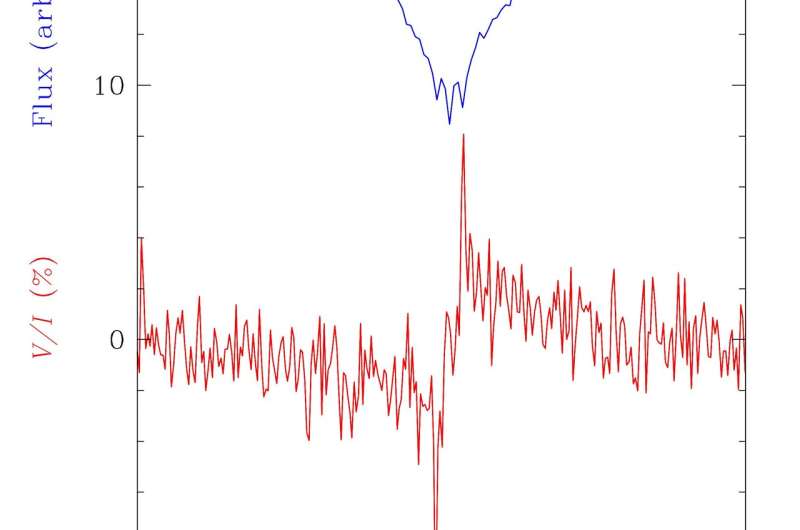The polarised spectrum of the magnetic white dwarf WD 0058-044 obtained with ISIS on September 19 2018. The blue solid line reveals Halpha split into a Zeeman triplet. The separation between the line components is proportional to the magnetic field strength averaged over the visible stellar disk. The red line shows the circularly polarised profile of the same line. Its shape depends on the component of the star's magnetic field along the line of sight, averaged over the stellar disk. Credit: Stefano Bagnulo and John Landstreet
Magnetic fields are present in a large variety of stars across the Hertzsprung-Russell diagram, during all evolutionary stages from pre-main sequence stars, to main sequence stars and evolved stars, up to the final stages when the star explodes as a supernova.
Magnetic fields play important roles in stellar evolution. They transfer angular momentum, both internally during stellar evolution, and externally during periods of accretion or mass loss. Even a fairly weak magnetic field can suppress convection in stellar atmospheres and affect cooling times of extremely old white dwarfs. While the effects of the magnetic fields are well observed and sometime even understood, the origin of stellar magnetic fields is often unknown, and we do not know how fields evolve as stars evolve.
Detection of a stellar magnetic field generally relies on observation of splitting and/or polarisation of spectral lines produced by the Zeeman effect. In a general way, splitting of spectral lines by the Zeeman effect is detected in a normal flux spectrum, and allows one to estimate the typical amplitude of the magnetic field, averaged over the star.
Circular polarisation in a spectral line makes it possible to detect the averaged line-of-sight component of the magnetic field, and can be sensitive to a magnetic field that is an order of magnitude or more weaker than that detectable from line splitting.
The distribution of magnetic field over the surface of the magnetic white dwarf WD 2359-434, as seen at five successive phases (left to right: phases 0.0, 0.2, 0.4, 0.6 and 0.8). Black arrows represent outward field, white arrows inward field. The axis of rotation is a small white line segment close to the top of each sphere. The scale at right is in units of 10 kG (e.g. 13.8 = 138 kG). Credit: Stefano Bagnulo, John Landstreet and Oleg Kochuckov
Interest has been increasing in recent years in obtaining a clear observational overview of the occurrence and characteristics of magnetic fields over the whole Herzsprung-Russell diagram. A very interesting example is the magnetic fields that occur in about 10% of white dwarfs, which range in strength from about 1kG (1 kiloGauss or 0.1 Tesla) to almost 1000 MG.
Because spectropolarimetry is the most sensitive of the available field discovery methods, astronomers have been using ISIS on the William Herschel Telescope (WHT), FORS on the Very Large Telescope (VLT), and Espadons on the Canada-France-Hawaii Telescope (CFHT). Each of these instruments has specific strengths.
Both ISIS and FORS are particularly well suited to detecting very weak fields in relatively faint (V > 14) white dwarfs. Remarkably, because ISIS can do spectropolarimetry at an optimal resolving power around the Halpha line in the red, it is possible to obtain the most sensitive field measurements, even though the telescope area is only one-quarter of that of the VLT. The ongoing ISIS survey to find more weak-field white dwarfs has the potential to substantially improve the knowledge of the actual distribution of magnetic field strengths among white dwarfs, to provide more bright examples of weak-field stars for detailed modelling and analysis, and to assist us in understanding whether magnetic fields decay during white dwarf cooling or whether some process(es) generate new magnetic flux.
More information: J. D. Landstreet et al. Monitoring and modelling of white dwarfs with extremely weak magnetic fields, Astronomy & Astrophysics (2017). DOI: 10.1051/0004-6361/201731432
S. Bagnulo et al. Searching for the weakest detectable magnetic fields in white dwarfs, Astronomy & Astrophysics (2018). DOI: 10.1051/0004-6361/201833235
Journal information: Astronomy & Astrophysics
Provided by Isaac Newton Group of Telescopes

























